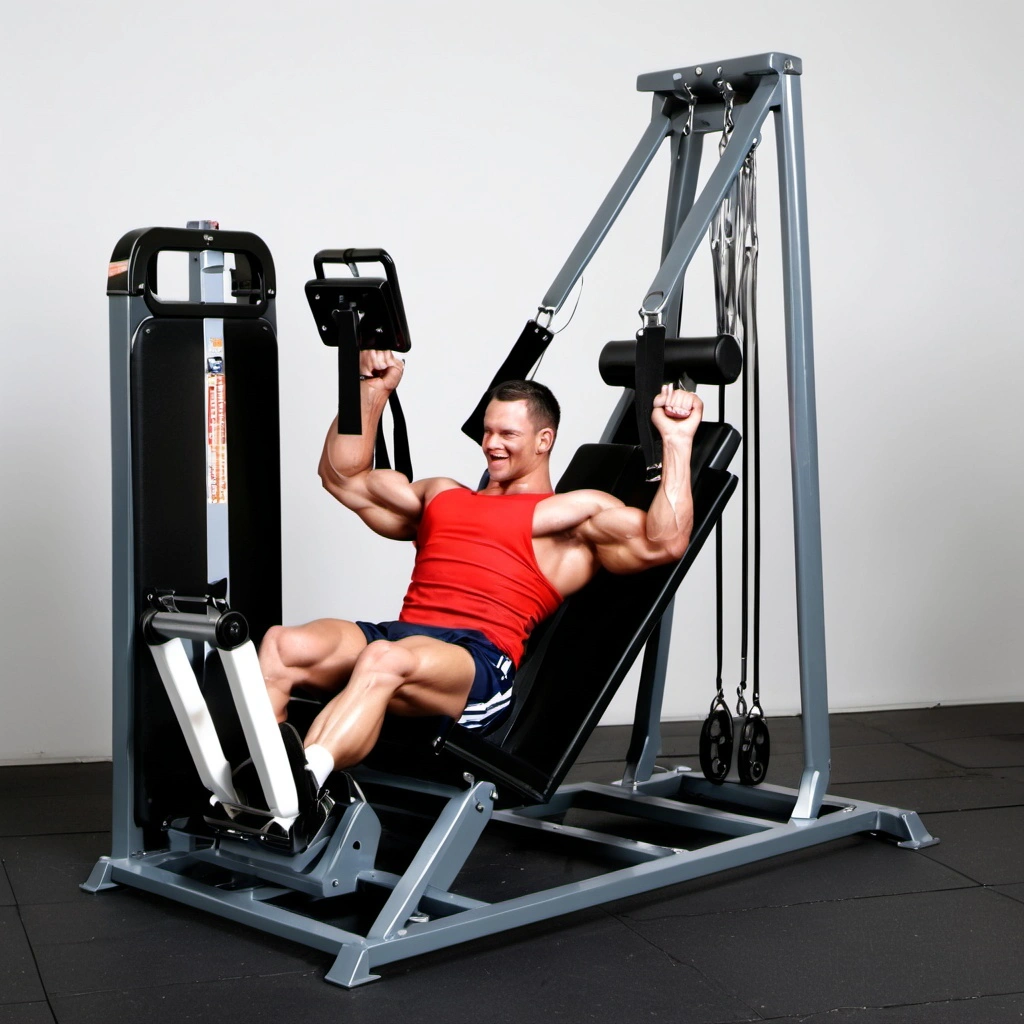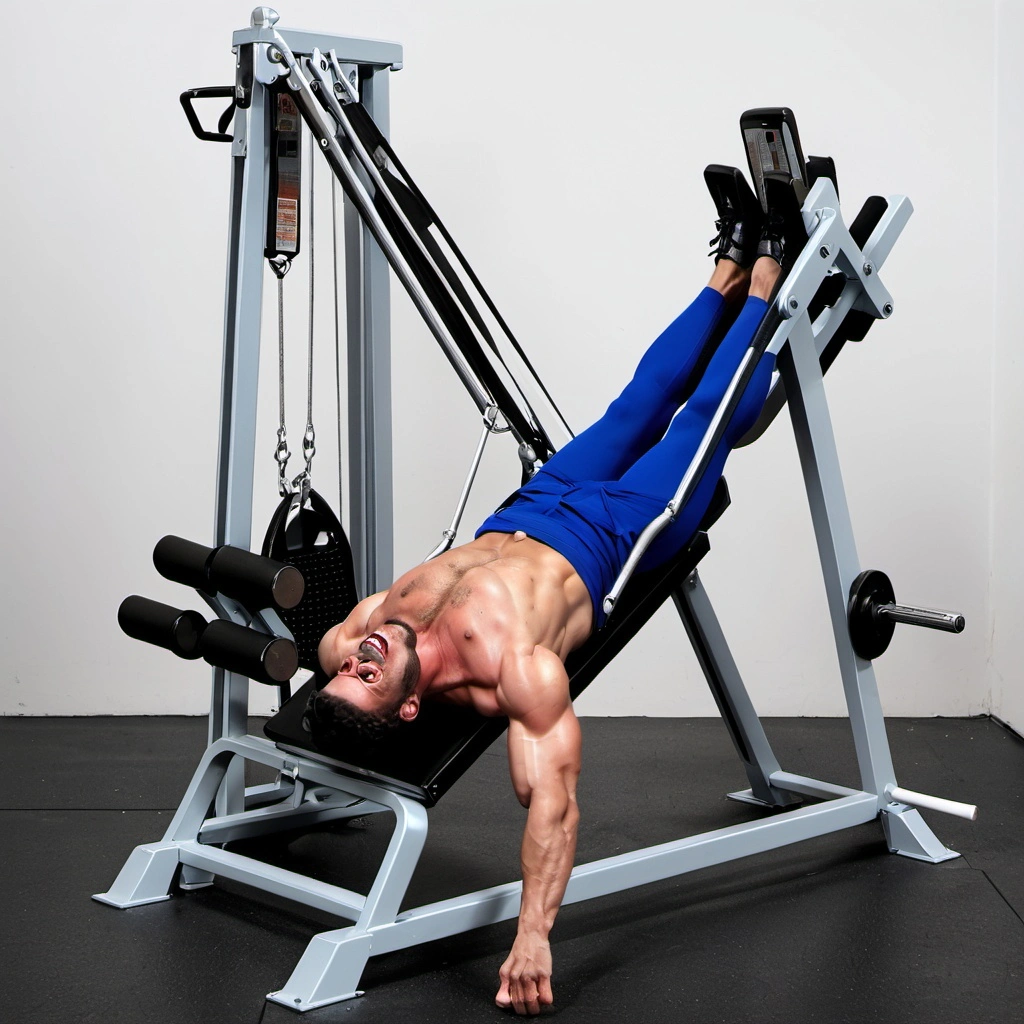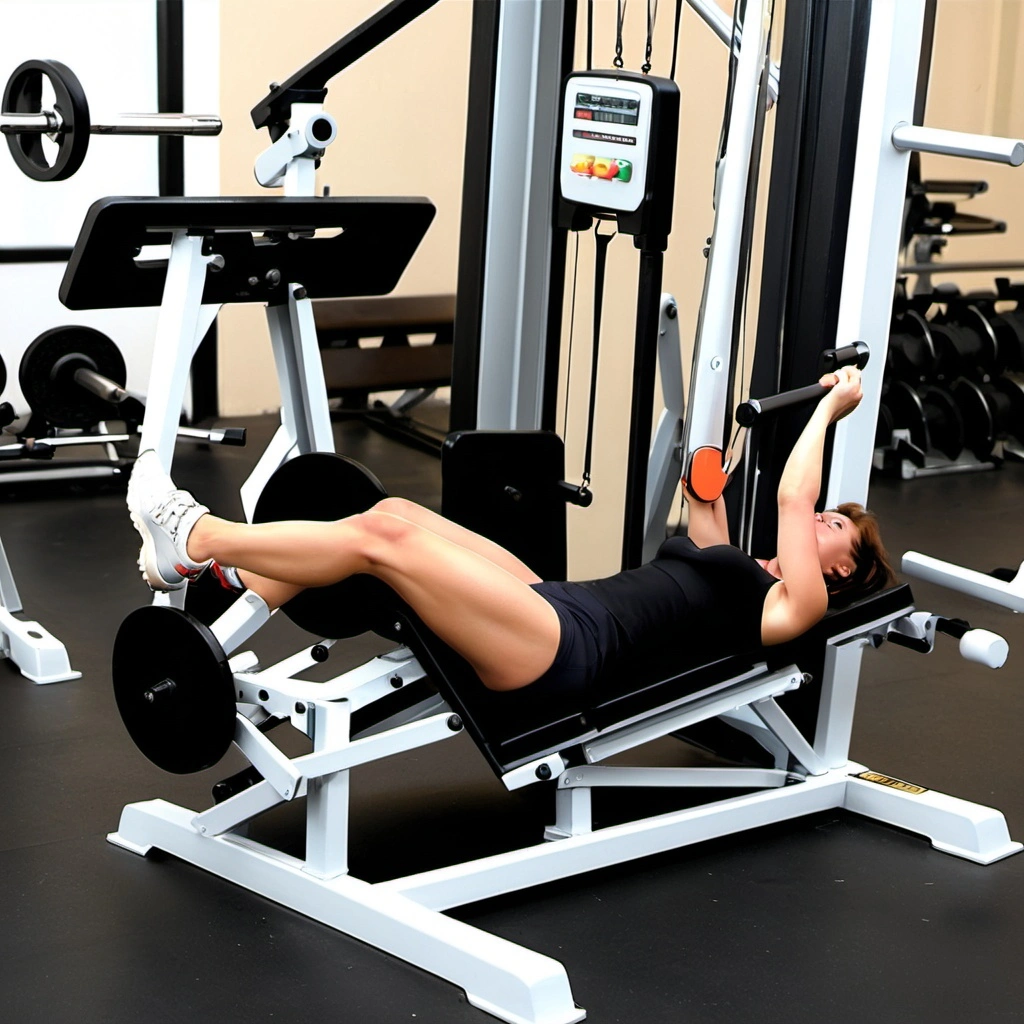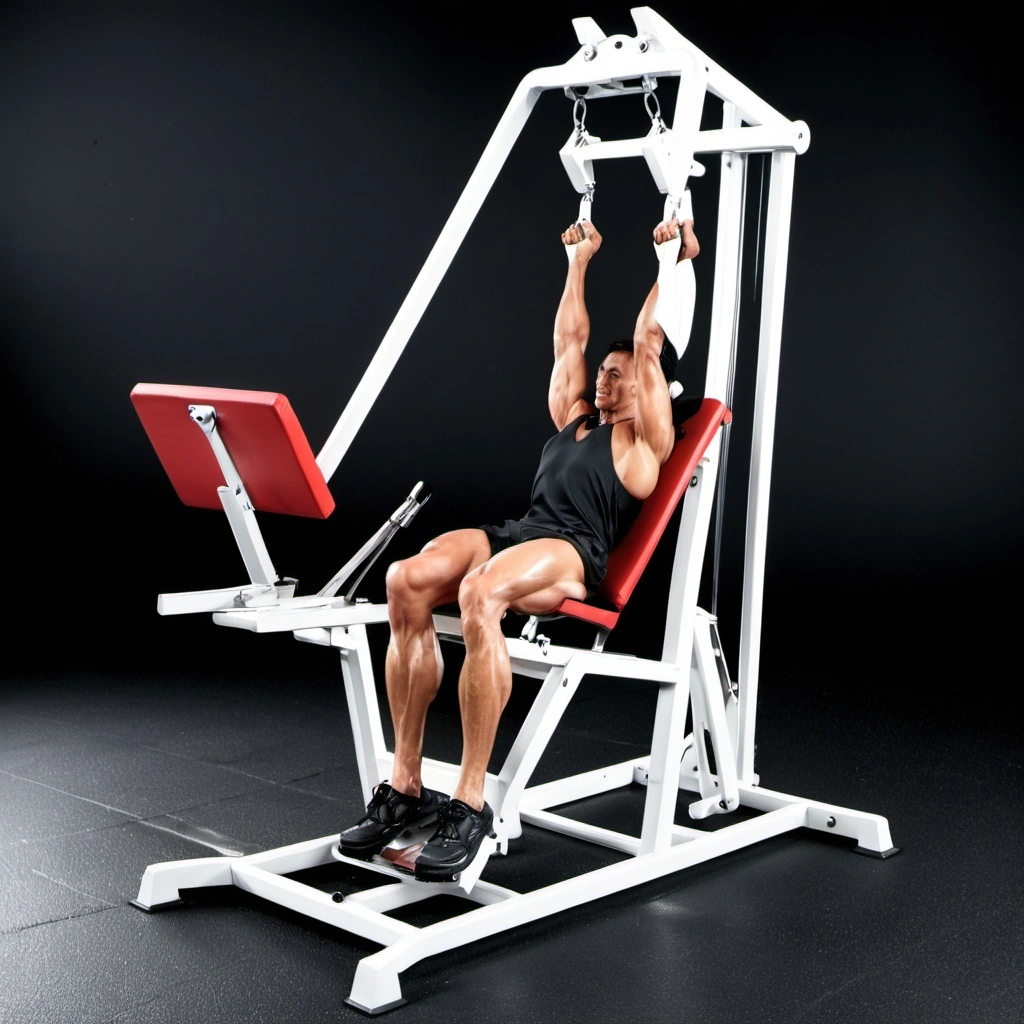The swinging leg press machine is also known as the pendulum leg press. It is a piece of exercise equipment found in gyms and fitness centers. It’s designed to target the muscles of the lower body. It focuses on the quadriceps, hamstrings, and glutes.
Here’s a Basic Introduction to Using the Swinging Leg Press Machine
- Adjust the seat first. Set it so that when you sit on it, your knees are at a 90-degree angle with the footplate.
- Select the Right Weight. Choose a weight that fits your fitness level and goals. You can adjust the weight by adding or removing weight plates from the machine.
- Position Yourself on the Machine: Sit on the seat with your back hard against the backrest. Step onto the footplate with your feet shoulder-width apart. Point your toes thin outward.
- Grip the handles. The machine’s design may have handles or grips for you to hold. Grip them hard to stabilize yourself during the exercise.
- Do the Exercise. Extend your legs to push the footplate away from your torso. But, be sure not to lock your knees at the top. Keep a controlled motion throughout the exercise. Then, to get back to the beginning position, bend your knees. When you push the weight away, exhale. When you return, inhale.
- Focus on Form: Pay attention to your form throughout the exercise. Avoid rounding your lower back and keep your chest up. You should move with control and fluidity.
- Adjust the seat or footplate if needed. Do this to make sure you’re comfy and aligned during the exercise.
- Reps and Sets: Aim for a suitable number of repetitions and sets based on your fitness level and goals. True, beginners may start with 2-3 sets of 8-12 repetitions.
- Cool Down: After your sets, take time to stretch. This will help your lower body muscles. It prevents soreness and boosts flexibility.
Frame Design
True! When designing a leg press machine frame that swings, there are several key things to ensure. It must be both useful and durable

- Material Selection: Start with a sturdy material like steel or heavy-duty aluminum. These materials offer the strength needed to withstand leg press pressure. They also ensure long-lasting durability.
- Design the frame to provide stability and support during use. This includes strategic bracing and reinforcement at stress points. These prevent wobbling or bending.
- Adjustability is the inclusion of features that allow for adjustments. These adjustments accommodate users of varying heights and sizes. This might include footplates and seats that adjust. They ensure proper alignment and motion for different people.
- Safety Features: Add locking mechanisms to secure the weight plates. They keep them in place during use. Also, add non-slip footplates. They prevent accidental slips or falls.
- Smooth Movement: Make sure the frame design allows smooth leg press movement. This might involve using high-quality bearings. It could also involve using pulley systems to cut friction and resistance.
- Space Efficiency: The frame design should fit users of different sizes. It should also save space. This is especially true in commercial gyms, where floor space is valuable.
- Functionality is paramount. But, the frame’s aesthetic appeal can enhance the user experience. This might involve sleek lines. It might use modern finishes. And, it pays attention to detail in the construction.
Seat and Backrest
Here are things to consider when designing an adjustable seat and backrest. They are for a swinging leg press machine. The design must fit users of different body types and preferences. It must also keep them comfortable during workouts.
- The seat and backrest should be easy to adjust. They should fit users of different heights and body types. Users can do this by using mechanisms. These include adjustable sliders or levers. They enable quick and precise adjustments.
- Range of Motion: Make sure the seat and backrest can move enough. This allows users to find their best position for leg presses. This may involve allowing both horizontal and vertical adjustments. They would cater to different body sizes.
- Use ample padding. Put it on both the seat and backrest. It provides comfort and support during workouts. High-density foam padding is often preferred as it offers both comfort and durability. Consider using contoured padding. It provides extra support to the lower back and thighs.
- Choose durable materials. They should be easy to clean and resistant to sweat and moisture. Gym equipment uses leather or synthetic leather upholstery. It is easy to maintain and long-lasting. Stability is key. The seat and backrest must be fast attached to the leg press machine’s frame. This prevents wobbling during use. Reinforce the attachment points. Use strong materials for the frame. This will enhance stability.
- Ergonomics are important. Examine the design of the seat and backrest. They promote good posture and alignment during workouts. Curved shapes reduce strain on the lower back. They also give the spine good support.
- Social Adjustments: The seat and backrest’s change mechanisms must be easy and intuitive. They should let users adjust them fast and soft without help.
Foot Plate
The footplate of a leg press machine swings. It is crucial for stability. It allows for various foot positions during the exercise. Here’s a breakdown of the features it should have:
- The foot plate should be big enough to fit different foot positions. Users may prefer wider or narrower stances. It depends on their comfort and the muscles they want to target.
- The footplate should have a textured surface or foot grips. These prevent slipping during the exercise. This ensures that users can exert force without worrying about their feet sliding. It enhances safety and effectiveness.
- The footplate bears the weight and force during leg presses. So, it should be durable and able to last without deteriorating.
- The foot plate should be ergonomic. It should promote natural foot positioning and alignment during the exercise. This helps reduce the risk of strain or injury. It also makes the workout more effective.
- Stability is key. A stable foot plate is essential. It keeps balance and control during the leg press. It should be safe attached to the machine frame and remain stable even under heavy loads.
Swinging Mechanism
Designing a leg press machine that swings sleek and secure requires careful attention. It needs good engineering and safety. Here’s a conceptual outline incorporating your specifications:
- Bearings or Pivot Points are key. Put them at strategic spots in the swinging mechanism. Use high-quality, durable ones. These parts should withstand the forces of the leg press. They should also provide smooth, frictionless movement.
- Add joints to the design. They let the leg press platform move along a set arc or path. These joints should help natural movement and prevent strain on the user’s joints.
- Add a hydraulic dampening system. It will control the speed and resistance of the swinging motion. This system can help regulate the leg press platform’s motion. It ensures smooth transitions between reps and stops sudden swinging or jerky movements.
- Add adjustable resistance. It will customize the intensity of the leg press. This could involve adding variable resistance settings. Or, it could allow users to add or remove weight plates. This would let them match their fitness level and goals.
- Safety Features: Rank safety by incorporating features to prevent accidents or injuries. This may include:
- Use switches or sensors to detect the most motion. They prevent overextension.
- Emergency stop buttons or safety locks to halt the swinging motion in case of an emergency.
- Non-slip footplates or grips to ensure stability and prevent slippage during the exercise.
- The product should have clear signs or diagrams. They will guide users on how to use it and on staying safe.
- Ensure the frame and structure are stable. They should be strong and robust. This involves using high-quality materials and construction techniques. They support the forces during the leg press.
- Consider adding social features. These could include ergonomic handles or grips. They could have seats that adjust and controls that are easy to use. The controls change settings or resistance.
- Maintenance and Durability: Design the leg press for easy maintenance. Use wear and corrosion resistant materials and parts. Also, provide access points for routine inspection, lubrication, and servicing.
Resistance System
A leg press machine should have a resistance system. It should let users adjust the weight to their fitness level. Here are a few options for implementing such a resistance system:
- This traditional method involves users adding or removing weight plates to adjust resistance. The machine could have pegs for stacking plates. Users can add or remove plates to adjust the resistance.
- A weight stack is common in many gym machines. Users can adjust the weight by moving a pin to select the desired resistance level on the weight stack. This offers quick and easy adjustments between sets or exercises.
- Hydraulic resistance uses hydraulic cylinders or pistons. They create resistance. Users can adjust the resistance by changing the hydraulic pressure. They can often do this with a dial or knob on the machine. Hydraulic resistance systems offer smooth and consistent resistance throughout the range of motion.
Each of these options has its own advantages and considerations. Weight plates offer flexibility but may must more time for adjustments. Sectorized weight stacks provide quick adjustments but may limit the range of resistance. Hydraulic resistance offers smooth resistance but may need more maintenance.
Handles or Grips
Adding handles or grips to a swinging leg press machine can help users. They improve the user’s experience and safety during the exercise. Here are some considerations for designing the handles or grips

- Design the handles. They should reduce strain on the hands and wrists. This may involve using materials with a comfortable grip. And shaping the handles to fit the hand’s natural curve.
- You can adjust the handles. This accommodates users of different heights and body types. This ensures that users can maintain proper form throughout the exercise.
- The handles or grips should be stable and supportive. They should support users during the exercise. This may involve adding padded grips. It may also involve sturdy construction. These features cut the risk of slipping or instability.
- Make sure that the handles are easy to reach. They should be reachable by users of varying abilities. This may involve putting them at a comfy height. You must also ensure that you can reach them without strain.
- Durability is key. Choose tough materials. They must withstand repeated use. This ensures that the handles will stay safe and work for users. It will be true for the whole life of the machine.
Safety Features
Adding safety features to a swinging leg press machine is crucial. They ensure the well-being of users. Here’s how you could incorporate the suggested safety features:
- Locking Mechanisms for Footplate:
- Design the leg press machine to swing. It needs a strong lock to hold the footplate in place when not in use.
- This could be a simple pin or latch. It stops the footplate from moving by accident.
- Emergency Stop Buttons or Levers:
- Install soft accessible emergency stop buttons or levers within reach of the user.
- These buttons or levers should stop the leg press machine right away. They halt the machine in emergencies like sudden pain or other surprises.
- Ensure that the emergency stop feature is net labeled and soft identifiable.
- Visual and Audible Alerts:
- Consider adding visual and audible alerts. When the footplate is not locked or when the emergency stop changes, they say.
- Visual alerts could have flashing lights or illuminated indicators. Audible alerts could be alarms or beeps.
- User Instructions and Safety Guidelines:
- Provide clear instructions and safety guidelines for using the swinging leg press machine.
- Make sure users learn how to engage the locks. They should also learn to find and use the stop buttons. And, they should see the importance of following safety rules during their workouts.
- Regular Maintenance and Inspections:
- Set a schedule for regular maintenance and inspections of the leg press machine. This will ensure that all safety features work well.
- Any broken parts should be quickly fixed or replaced. This will keep the equipment safe.
User Interface
Here’s a concept for the user interface of a swinging leg press machine. It will have social controls and tracking features.
- The machine has a digital display at the front. It shows real-time feedback on workout metrics. These include weight, repetitions, and session duration. It also displays the selected settings for the workout.
- The interface is a touch screen. It lets users adjust settings. These include weight resistance, range of motion, and rest intervals. Users can tap or swipe on the screen to make adjustments.
- The touch screen has pre-set workout programs. Tailors design them to suit various fitness goals. These goals include strength building, muscle toning, and endurance training. Users can select a program and the machine adjusts settings noted.
- Customizable Workouts: Advanced users can customize workouts. They do this by setting parameters. These include the number of sets, repetitions, and rest intervals. The touch screen interface guides users through the customization process with clear instructions.
- The machine has biometric sensors. They check heart rate and calorie expenditure. This allows for enhanced tracking capabilities during the workout. The screen displays the data in real time. It can sync with a mobile app for long-term tracking and analysis.
- The interface also includes safety features. These include emergency stop buttons and visual indicators. They ensure users can use the machine.
- Users can create profiles on the machine’s interface. They use them to store their workout preferences and track progress. This allows for a more personalized workout experience.
Instructional Materials
Sure! Here are some easy-to-understand instructions for using a swinging leg press machine:
Adjust the Seat
- Sit on the seat of the leg press machine.
- Adjust the seat to ensure that your knees form a 90-degree angle when you place your feet on the footplate.
- Ensure your back is fully supported against the backrest.
Foot Placement
- Place your feet shoulder-width apart on the footplate.
- Position your feet so that they are flat and centered on the footplate.
- Make sure your heels are fast planted. They should not lift off the footplate during the exercise.
Grips
- Hold onto the handles provided on the sides of the seat for stability.
- Keep a firm grip on the handles throughout the exercise.
Perform the Exercise
- Push the footplate away from your body by extending your legs.
- Exhale as you push the weight away from your body.
- Extend your legs full without locking your knees.
- Hold the position for a brief moment at the top of the movement.
- Easy bend your knees to return to the starting position.
- Inhale as you bend your knees and bring the weight back towards your body.
- Repeat for the desired number of repetitions.
Safety Tips
- Start with a light weight. Then, increase the resistance as you get more comfortable with the exercise.
- Avoid locking your knees at the top of the movement to prevent injury.
- Maintain control throughout the exercise and avoid using momentum to move the weight.
- If you feel pain or discomfort, stop the exercise. Consult a fitness pro.
Cool Down
- Once you have finished your desired reps, lower the weight. Then, put the footplate back at the start.
- Take a moment to stretch your legs and lower body to help prevent muscle soreness.
Maintenance and Durability
Designing a leg press machine that swings is the goal. It must focus on maintenance and durability. This requires attention to many key aspects:
- Accessible Components: Design the machine with easy-to-reach parts. They need regular maintenance, like cleaning and lubrication. Make sure no part of the machine is hard to reach. And, ensure no part needs special tools for maintenance.
- Modular Design: Create a modular design. It should allow for easy break and of components. This makes maintenance and repair easier. It allows quick access to parts without needing to dismantle the whole machine.
- Use high-quality, tough materials. Use stainless steel or heavy-duty aluminum. Use them for the frame and structural parts. These materials provide great strength and corrosion resistance. They ensure the machine lasts even in harsh places.
- Reinforce critical joints and welds. They need to withstand the repeated stress and load put on the machine during use. Use advanced welding. Ensure thorough inspections to remove weak points. Weak points could cause early failure.
- Use sealed bearings and bushings in key pivot points. This will reduce friction and wear. Sealed bearings protect against dust, dirt, and moisture. This prolongs their life and cuts the need for frequent replacement.
- Apply protective coatings. These include powder coating and electroplating. Apply them to all exposed metal surfaces. They enhance corrosion resistance and durability. These coatings also make cleaning easier by preventing the buildup of dirt and grime.
- Incorporate adjustable mechanisms for seat height, backrest angle, and footplate position. These will fit users of different sizes and preferences. Make sure the change mechanisms are strong. They should be easy to use without reducing stability or safety.
- Provide clear maintenance instructions. Include recommended cleaning, lubrication, and inspection. Include illustrations or diagrams to assist users in performing routine maintenance tasks proper.
Aesthetics
Making a good leg press machine is about looks, function, and comfort. Here are some design considerations to enhance its aesthetics

- Choose a sleek design. It should have clean lines and smooth curves. These give the machine a modern and sophisticated look.
- Choose premium materials. They can be stainless steel, aluminum, or high-grade plastics. These materials ensure durability and add elegance to the machine.
- Use contrasting colors. They should contrast with the surroundings. They should promote a sense of energy and vitality. Using both bright and neutral colors can make the machine stand out.
- Design the seat and backrest. This will ensure comfort during workouts. Use high-quality, durable padding. It’s covered in a material that is both comfy and easy to clean.
- Integrated LED Lighting adds subtle LED elements to the design. They highlight key machine features and create a welcoming gym ambiance.
- Incorporate the gym’s logo or branding elements Sour into the design. This will reinforce brand identity and create a unified look for users.
- Consider space limits in gyms. Design a compact, space-efficient machine. It should not compromise on function or looks.
- Install intuitive controls. Make a interface. It will enhance the experience. It will encourage users to engage with the machine.
- The showcase would display the leg press mechanism. It would be optical appealing and show how the machine works. Users could see it in action. And it would keep them safe and work well.
- Incorporate minimalistic signs and graphics. They will guide users on how to use the machine. They will avoid cluttering the design.
Testing and Certification
Testing and certifying a swinging leg press machine is crucial. It is for safety and functionality before bringing it to market. This is to ensure the well-being of users and compliance with regulations. Here’s a comprehensive approach:
- Functional Testing
- Test the swinging motion. Make sure the swing moves Sleek. It should have no jerks or resistance.
- Test the leg press platform. Make sure it can support the intended weight without bending or wobbling.
- Test adjustable features. Check if the machine has settings for different user heights or leg lengths. Make sure they work well and lock in place.
- Test the safety locks. Check that they engage properly to prevent accidents.
- Load Testing
- Slowly increase the weight on the machine. Increase it to the max. This will ensure it can handle its intended use without breaking.
- Do repetitive stress tests to simulate regular use. These tests show weak points and areas prone to wear and tear.
- Safety Testing
- Check for pinch points. Also, check for areas where users could get fingers or clothing stuck.
- Assess the stability of the machine during use to prevent tipping or instability.
- Ensure that guards are in place on all moving parts to prevent accidental contact.
- Test emergency stop mechanisms. Ensure they halt the machine right away in an emergency.
- Electrical Safety (if applicable)
- If the machine has electrical parts, like digital displays or motorized adjustments. Be sure they meet electronics safety standards.
- Test for insulation resistance, grounding, and electrical continuity to prevent electric shock hazards.
- Compliance with Regulations
- Research and understand the safety standards and regulations for fitness equipment. They apply to the target market(s).
- Make sure the leg press machine’s design meets these standards. It should also pass construction standards.
- Get certification from accredited testing laboratories or regulatory bodies to prove compliance.
- Documentation
- Keep detailed records. Include all testing procedures, results, and any changes to improve safety or functionality.
- Prepare user manuals and safety instructions under regulatory requirements.
- User Feedback
- Test the machine with users of varying fitness levels. Get feedback on comfort, ease of use, and satisfaction.
- Use this feedback. Make any needed adjustments before finalizing the design.

